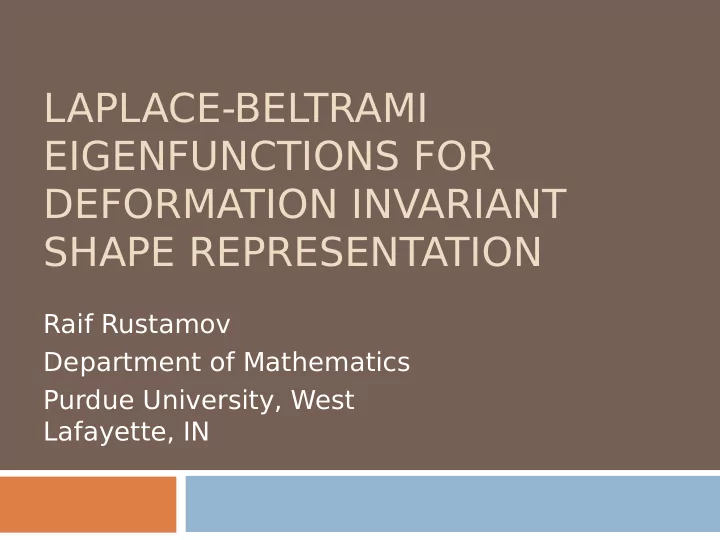

LAPLACE-BELTRAMI EIGENFUNCTIONS FOR DEFORMATION INVARIANT SHAPE REPRESENTATION Raif Rustamov Department of Mathematics Purdue University, West Lafayette, IN
Motivation Deformable shapes Computer graphics Shape modeling Medical imaging 3D face recognition Achieve deformation/pose invariant Retrieval/matching Correspondence Segmentation
General approach Natural articulations pair-wise geodesic distances change little isometries – metric tensor stays same Deformation invariant embedding Only metric properties are used Produce an embedding of the surface into (higher dimensional) Euclidean space The object and its deformations have the same embedding Segmentation, descriptor extraction, etc. uses this embedding – deformation invariance is achieved
Geodesics based embeddings Spectral embedding – MDS, Jain-Zhang Pairwise geodesic distances between points Flatten this structure – get embedding Euclidean distance in embedding = geodesic dist. Successful: classification, correspondence, segmentation Problems: Geodesic distances are sensitive to local topology changes A “short circuit” can affect a lot of geodesics
Our approach Construct an embedding Geodesic distances are never used Laplace-Beltrami eigenfunctions guide the construction Eigenfunctions have global nature more stability to local changes Eigenfunctions are isometry invariant Deformation invariant representation
Laplace-Beltrami Egenvalues, eigenfunctions solve Eigenvalues: Eigenfunctions: Constitute an orthogonal basis Bruno Levy: this basis is the one !
Global Point Signatures Given a point p on the surface we define is the value of the eigenfunction at the point p Reason for square roots will be explained later
GPS embedding GPS can be considered as a mapping from the surface into infinite dimensional space. The image of this map will be called the GPS embedding of the surface. The infinite dimensional ambient space the GPS domain
Property 1: distinctness A surface without self-intersections is mapped into a surface without self- intersections In other words: distinct points have distinct images under the GPS .
Property 2: invariance GPS embedding is an isometry invariant. Two isometric surfaces will have the same image under the GPS mapping Same GPS embedding Reason: Laplace-Beltrami operator is defined completely in terms of the metric tensor LB is isometry invariant LB eigenvalues and eigenfunctions of isometric surfaces coincide - their GPS embeddings also coincide
Property 3: reconstruction Given the GPS embedding and the eigenvalues, one can recover the surface up to isometry Eigenvalues and eigenvectors of LB uniquely determine the metric tensor. This stems from completeness of eigenfunctions, which implies the knowledge of Laplace-Beltrami, from which one immediately recovers the metric tensor and so, the isometry class of the surface.
Property 4 GPS embedding is absolute: it is not subject to rotations or translations of the ambient infinite-dimensional space. Compare with Geodesic MDS embedding Determined only up to translations and rotations there is no uniquely determined positional normalization relative to the embedding domain. In order to compare two shapes, one still needs to find the appropriate rotations and translations to align the MDS embeddings of the shapes
Property 4, cntd. The GPS embedding is uniquely determined two isometric surfaces will have exactly the same GPS embedding except for reflections, because the signs of eigenfunctions are not fixed no rotation or translation in the ambient infinite dimensional space will be involved Example: the center of mass of the GPS embedding will automatically coincide with the origin
Property 5: meaningful distance The inner product and, thereby, the Euclidean distance in the GPS domain have a meaningful interpretation Green’s function G( x , x’ ) The dot product in ambient space has meaning:
Discrete Setting Use Laplacian of Xu It is not symmetric We explain how to handle the non- symmetry Several novel remarks: complementary to “No Free Lunch”: Wardetzky et al. prove that there is no discrete Laplacian that satisfies a set of requirements including symmetry We show that one should not require a Laplacian to be symmetric Also see “Symmetric Laplacian Considered Harmful”
Experiments Deformable shape classification G2 distributions A variant of D2, but computed on the GPS embedding Automatically deformation (isometry) invariant
Stability The global nature of eigenfunctions makes the G2 stable under local topology changes: welded blue
Isometry invariance: dataset Yoshizawa et al.
Isometry invariance: MDS plot
Sample segmentation K-means clustering in the GPS, not optimized
Problems Inability to deal with degenerate meshes Surfaces with boundaries impose appropriate boundary conditions. Two problems while working with eigenvalues and eigenvectors in general: the signs of eigenvectors are undefined two eigenvectors may be swapped Using D2 distributions indirectly addresses both of these issues. Further analysis is needed to clarify the consequences of these factors for shape processing when the GPS embedding is used directly
Acknowledgements Doctor Steve Novotny for not putting my fractured finger into a cast – this paper would not be possible Anonymous reviewers for their detailed and useful comments -- helped improve the paper immensely All models except the Dinopet and the sphere are from AIM@SHAPE Shape Repository; Deformations of Armadillo courtesy Shin Yoshizawa; the rest of the models are courtesy of INRIA
Recommend
More recommend